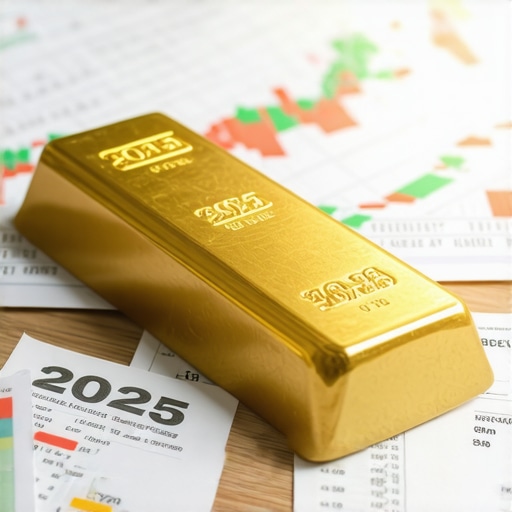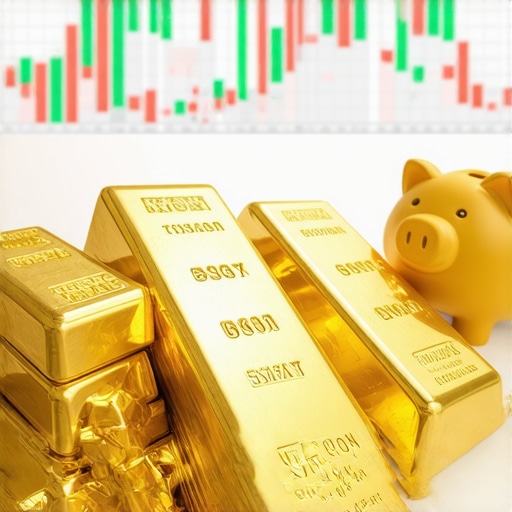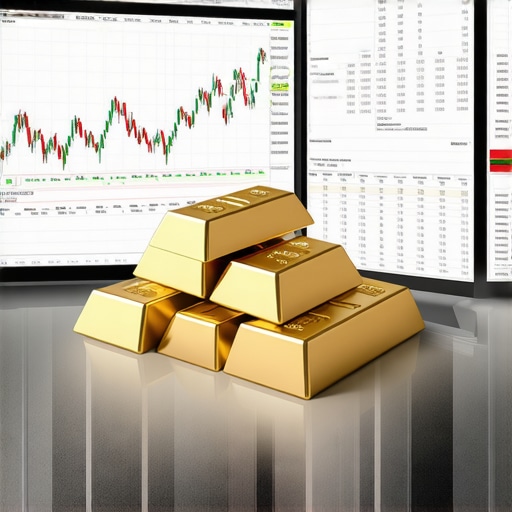Strategizing Gold Investments: Aligning ETFs and Mutual Funds with Your Financial Objectives
In the contemporary investment landscape, gold remains a pivotal asset class for portfolio diversification and inflation hedging. Selecting the optimal gold exchange-traded funds (ETFs) and mutual funds demands a nuanced understanding that transcends basic asset allocation. Investors must evaluate fund structures, underlying assets, expense ratios, and alignment with long-term goals to maximize returns and mitigate risks effectively.
Decoding Gold ETF and Mutual Fund Structures: Beyond Surface-Level Analysis
Gold ETFs typically offer direct exposure to physical gold or gold futures contracts, while mutual funds might invest in gold mining equities or a blend of gold-related assets. The structural differences influence liquidity, volatility, and tax implications. For instance, ETFs often provide intraday trading flexibility, whereas mutual funds trade once daily but may offer professional management advantages. Understanding these nuances is essential for tailoring investment choices to individual risk tolerance and time horizons.
What advanced metrics should investors analyze to discern the best-performing gold ETFs and mutual funds?
Expert investors prioritize metrics such as tracking error, fund expense ratio, average daily volume, and the fund’s asset composition. A low tracking error indicates fidelity to gold price movements, crucial for ETFs physically backed by bullion. Expense ratios impact net returns over time and should be weighed against fund performance consistency. Additionally, evaluating the fund manager’s expertise and the fund’s historical performance during market volatility periods provides deeper insight into potential resilience.
Integrating Macroeconomic Indicators and Market Dynamics in Fund Selection
Gold investment efficacy is intricately linked to global economic factors such as inflation rates, central bank policies, currency fluctuations, and geopolitical tensions. Funds with diversified exposure—combining bullion, mining stocks, and derivatives—may offer enhanced risk-adjusted returns during turbulent periods. Conversely, pure bullion-backed ETFs serve as a more direct inflation hedge. Incorporating macroeconomic trend analysis enables investors to select funds that align with anticipated market conditions.
Evaluating Dividend Yield Stability and Growth Potential in Gold Mutual Funds
Some gold mutual funds emphasize consistent dividend income through investments in established mining companies with robust cash flows. Assessing dividend yield stability alongside capital appreciation potential is vital for income-focused investors. Comparative studies, such as those found in best gold ETFs and mutual funds for consistent dividend income, provide valuable frameworks for selection.
Risk Management and Portfolio Integration: Advanced Considerations
Incorporating gold ETFs and mutual funds requires balancing exposure to systemic risks, including commodity price volatility and operational risks inherent in mining equities. Diversification across fund types and geographies, combined with vigilant monitoring of fund liquidity and redemption terms, mitigates potential downside. Investors should also consider the tax treatment of ETF distributions versus mutual fund dividends, as these impact net returns.
For a comprehensive exploration of stable income options within gold investment vehicles, consider reviewing our detailed analysis on gold ETFs and mutual funds best choices for stable income.
Actionable Next Steps for Sophisticated Investors
To deepen your strategic approach, examine the interplay of gold market trends and fund performance metrics by exploring expert-level insights in mastering gold market analysis at mastering gold market analysis insights for savvy investors. Share your experiences and advanced strategies in professional forums to contribute to the evolving discourse on gold investment optimization.
Authoritative research such as the World Gold Council’s comprehensive reports on gold market dynamics offer invaluable data and analysis to inform your investment decisions (World Gold Council Research).
Harnessing Quantitative Models to Predict Gold Fund Performance
As the gold market becomes increasingly complex, leveraging quantitative models offers investors a sophisticated edge in forecasting fund performance. Techniques such as multifactor regression analysis can correlate gold prices with macroeconomic indicators like real interest rates, currency strength, and geopolitical risk indices. These models not only help anticipate price movements but also assist in identifying funds whose performance is most sensitive to underlying economic variables. Incorporating such analytics into your decision-making process enhances portfolio resilience and capitalizes on emerging trends.
Environmental, Social, and Governance (ESG) Considerations in Gold Mutual Funds
ESG factors are gaining prominence in investment decisions, including within gold mutual funds. Mining companies with robust environmental stewardship, fair labor practices, and transparent governance policies are increasingly favored by ethical investors and can contribute to sustainable long-term returns. Evaluating funds based on their ESG screening criteria and engagement strategies helps align investments with broader social values while potentially mitigating regulatory and reputational risks. The integration of ESG metrics presents an advanced dimension for discerning investors seeking impact alongside profit.
How can integrating ESG criteria reshape the risk-return profile of gold ETFs and mutual funds?
Integrating ESG criteria often leads to a more selective investment universe, excluding companies with questionable mining practices or governance challenges. This selectivity can reduce exposure to operational controversies that may negatively impact share prices, thus lowering downside risk. Conversely, it may limit diversification and potentially exclude high-performing assets, affecting returns. However, funds emphasizing ESG principles may benefit from growing investor demand and regulatory incentives, which can enhance valuation and long-term stability. A balanced approach that assesses ESG integration depth alongside financial metrics is critical for optimizing the risk-return tradeoff.
Dynamic Asset Allocation: Balancing Gold Exposure Amid Volatile Markets
Dynamic asset allocation strategies enable investors to adjust gold ETF and mutual fund weightings in response to shifting economic cycles and market volatility. For instance, increasing exposure during periods of heightened inflation expectations or geopolitical uncertainty can protect portfolio value, while reducing it during stable growth phases may improve overall returns. Utilizing tactical allocation frameworks supported by real-time data and predictive analytics helps maintain an optimal balance between risk mitigation and capital appreciation.
For those interested in refining portfolio construction techniques with gold investments, our guide on how to build a balanced gold ETF portfolio for 2025 growth offers actionable insights.
Leveraging Expert Resources and Market Intelligence for Informed Decisions
Staying abreast of authoritative market intelligence is crucial for advanced gold investors. The World Gold Council’s Gold Hub provides comprehensive research reports, market data, and trend analyses that empower investors to anticipate shifts and adapt strategies accordingly. Additionally, engaging with peer-reviewed financial journals and subscribing to specialized commodity market newsletters enhances analytical depth and situational awareness.
Engage with our community: Share your expert strategies or inquire about integrating ESG factors and quantitative models in gold fund selection. Your insights can enrich the collective knowledge and inform emerging best practices.
Harnessing Machine Learning for Predictive Analytics in Gold Fund Performance
Beyond traditional multifactor regression models, the integration of machine learning algorithms offers a frontier for forecasting gold fund returns with enhanced precision. Techniques such as random forests, support vector machines, and neural networks can analyze vast datasets encompassing historical price movements, macroeconomic indicators, sentiment analysis from news sources, and geopolitical event frequencies. These models dynamically adjust to nonlinear relationships and complex interactions that classical models may overlook, thereby refining timing strategies and fund selection processes.
For example, incorporating sentiment scores derived from natural language processing of financial news can better capture market psychology’s effect on gold prices and, by extension, fund performance. Such holistic data-driven approaches not only bolster predictive accuracy but also enable scenario simulations to stress test portfolio resilience under diverse economic conditions.
What are the challenges and limitations of applying machine learning models to gold ETF and mutual fund performance forecasting?
While machine learning provides powerful tools, it is not without pitfalls. Model overfitting remains a critical concern, particularly when training on limited or noisy financial data. The black-box nature of some algorithms may obscure interpretability, complicating the explanatory insights crucial for investment committees and regulatory compliance. Data quality and the frequency of updates also affect model reliability, especially in volatile markets.
Furthermore, models trained on historical data may struggle with unprecedented market shocks or regime changes, such as sudden geopolitical conflicts or policy shifts. Therefore, hybrid approaches that combine domain expertise with machine learning outputs are advised to balance quantitative rigor with contextual judgment.
Integrating Blockchain Transparency and Tokenization in Gold Fund Investments
Emerging technologies like blockchain are beginning to reshape gold investment vehicles by enhancing transparency and liquidity. Some gold ETFs now utilize blockchain-based platforms to provide real-time auditing of physical gold holdings, thereby reducing counterparty risks and improving investor confidence. Tokenization of gold assets enables fractional ownership and 24/7 trading possibilities, broadening accessibility for retail and institutional investors alike.
This paradigm shift also facilitates seamless integration with decentralized finance (DeFi) ecosystems, opening avenues for innovative yield generation strategies, such as collateralized lending against tokenized gold holdings. However, regulatory frameworks governing these innovations remain in flux, necessitating cautious adoption and thorough due diligence.
Advanced Tax Efficiency Strategies for Gold ETFs and Mutual Funds
Tax implications significantly influence net returns from gold investments. Sophisticated investors employ strategies such as tax-loss harvesting within mutual funds, timing distributions to optimize capital gains treatment, and leveraging tax-advantaged accounts for holding gold ETFs. Additionally, understanding the distinction between collectibles tax rates for physical gold and the preferential treatment that certain ETFs enjoy can inform fund selection.
Consultation with tax professionals who specialize in commodities and securities remains indispensable. Utilizing fund structures domiciled in favorable jurisdictions or funds that implement in-kind redemptions can further enhance tax efficiency, ultimately improving after-tax performance.
For a deep dive into structuring tax-efficient gold investment portfolios, consider our specialized analysis at Tax-Efficient Gold Investment Strategies.
Synergizing Gold Fund Investments with Alternative Asset Classes for Portfolio Robustness
Integrating gold ETFs and mutual funds with other alternative assets like real estate investment trusts (REITs), commodities indices, and infrastructure funds can foster robust diversification that mitigates systemic risks. Gold often exhibits low or negative correlation with traditional equity and fixed income markets, but the inclusion of complementary alternatives can further smooth portfolio volatility.
Advanced portfolio optimization techniques, such as mean-variance optimization augmented with downside risk metrics (e.g., Conditional Value at Risk), enable investors to calibrate allocations that balance growth ambitions with drawdown protection. Dynamic rebalancing strategies can respond to shifting correlations and volatility regimes, thus maintaining the portfolio’s intended risk-return profile.
Incorporating scenario analysis under varying economic outlooks ensures that gold’s role as a hedge is effectively leveraged alongside other alternatives, aligning with investor-specific objectives.
Exploring Gold Derivatives within Mutual Fund Portfolios for Enhanced Yield and Risk Management
Some actively managed gold mutual funds employ derivatives such as options, futures, and swaps to amplify returns or hedge downside risks. Sophisticated use of covered call writing strategies or protective puts can generate incremental income or limit losses during adverse market movements. However, derivatives introduce counterparty and liquidity risks, requiring rigorous oversight and transparency.
Investors should scrutinize mutual fund prospectuses for clear disclosure on derivative use, risk controls, and the manager’s track record in derivatives strategies. Understanding the interplay between derivatives and underlying physical or equity gold exposures is essential for comprehensive risk assessment.
Explore further insights into derivatives integration in gold funds at Advanced Derivatives Strategies in Gold Funds.
Embracing ESG Integration: Navigating Ethical Investment Frontiers in Gold Funds
Incorporating Environmental, Social, and Governance (ESG) criteria into gold ETFs and mutual funds transcends traditional financial metrics to offer a multidimensional assessment framework. By rigorously evaluating mining companies’ sustainability practices and governance structures, investors can mitigate reputational risks and align portfolios with evolving regulatory landscapes. This ethical lens also uncovers opportunities in firms pioneering green mining technologies and community engagement, which may signal resilience and growth potential amid tightening environmental standards.
Machine Learning Advances: Transforming Predictive Analytics for Gold Fund Performance
Machine learning methodologies have ushered in unprecedented capabilities in decoding the complex interplay of variables influencing gold fund returns. Algorithms like random forests, support vector machines, and deep neural networks assimilate diverse datasets—ranging from macroeconomic indicators and commodity price fluctuations to sentiment analysis derived via natural language processing of financial media. These techniques adapt dynamically to nonlinear relationships and emergent market anomalies, enabling investors to refine timing strategies and identify undervalued funds with enhanced precision.
What are the core challenges in deploying machine learning for forecasting gold ETFs and mutual funds, and how can they be mitigated?
Despite their strengths, machine learning models grapple with overfitting risks, especially when confronted with limited or noisy financial data. The opacity of complex algorithms often hinders interpretability, complicating decision-making and regulatory compliance. Furthermore, sudden macroeconomic regime shifts or geopolitical upheavals may render models trained on historical data less reliable. To address these challenges, hybrid approaches that fuse quantitative outputs with seasoned domain expertise are paramount, ensuring robustness and context-aware insights.
Blockchain and Tokenization: Revolutionizing Transparency and Liquidity in Gold Investments
Blockchain technology is redefining gold investment paradigms by enabling immutable, real-time audit trails of physical gold holdings within ETFs. Tokenization initiatives facilitate fractional ownership, democratizing access and introducing 24/7 trading capabilities beyond traditional market hours. These innovations also interface seamlessly with decentralized finance (DeFi) platforms, unlocking novel yield-generation avenues such as collateralized lending against tokenized gold assets. However, investors must remain vigilant regarding evolving regulatory frameworks and counterparty risks inherent in nascent digital infrastructures.

Advanced Tax Optimization: Navigating Complexities to Maximize After-Tax Returns
Tax-efficient structuring of gold ETF and mutual fund portfolios is crucial to enhancing net investment outcomes. Strategies include judicious tax-loss harvesting within mutual funds, optimizing distribution timing to leverage preferential capital gains treatment, and utilizing tax-advantaged accounts. Awareness of distinctions between collectibles tax rates applied to physical gold and the more favorable treatment afforded certain gold ETFs informs fund selection and jurisdictional considerations. Collaborating with tax professionals specialized in commodity taxation ensures compliance and strategic advantage.
Synergistic Portfolio Construction: Integrating Gold with Alternative Assets for Enhanced Robustness
Augmenting gold exposure with complementary alternative assets such as REITs, infrastructure funds, and commodity indices fosters a fortified diversification framework. Employing sophisticated portfolio optimization techniques—incorporating mean-variance analysis enhanced by downside risk metrics like Conditional Value at Risk—enables fine-tuned allocation decisions balancing growth aspirations and drawdown mitigation. Dynamic rebalancing responsive to shifting asset correlations and volatility regimes preserves the intended risk-return equilibrium.
Derivatives in Gold Mutual Funds: Sophisticated Yield Enhancement and Risk Hedging
Selective use of derivatives within actively managed gold mutual funds can amplify returns and manage downside risk effectively. Strategies such as covered call writing and protective put options generate incremental income streams and provide loss protection during adverse market phases. Nonetheless, derivative instruments introduce counterparty and liquidity risks necessitating stringent governance and transparency. Investors must rigorously evaluate fund disclosures regarding derivative utilization and risk management protocols to ensure alignment with investment objectives.
Leveraging Authoritative Research to Stay Ahead in Gold Fund Investment Strategy
For investors seeking to deepen their expertise, the World Gold Council’s Gold Hub remains an indispensable resource. Its comprehensive research reports, market analyses, and forward-looking insights provide a nuanced understanding of gold market dynamics, enabling informed fund selection and tactical portfolio adjustments. Continuous engagement with such high-caliber knowledge bases fortifies strategic decision-making in an ever-evolving investment landscape.
Engage with our advanced community discussions or consult our detailed resource compilations to harness these innovative methodologies and insights in your gold investment journey.
Expert Insights & Advanced Considerations
Embrace Multifaceted Quantitative and Qualitative Analysis
Successful gold ETF and mutual fund selection transcends simple price tracking by integrating multifactor regression models and machine learning with deep domain expertise. This hybrid approach mitigates overfitting risks and contextualizes market anomalies, enabling more precise performance forecasts and tactical allocation decisions aligned with evolving macroeconomic indicators.
Prioritize ESG Integration Without Sacrificing Diversification
Incorporating Environmental, Social, and Governance criteria refines the investment universe, reducing operational and reputational risks. However, balancing ESG selectivity with portfolio diversification ensures resilience and avoids concentration pitfalls, ultimately supporting sustainable returns in gold-related assets.
Leverage Blockchain and Tokenization to Enhance Transparency and Liquidity
Adopting blockchain-enabled audit trails and tokenized gold assets revolutionizes investor confidence and market accessibility. These innovations facilitate fractional ownership and 24/7 trading while offering integration with decentralized finance (DeFi) platforms, though they demand careful navigation of regulatory uncertainties and emerging counterparty risks.
Strategically Utilize Derivatives Within Gold Mutual Funds
Derivatives such as options and futures offer sophisticated yield enhancement and risk mitigation tools when deployed judiciously. Understanding fund disclosures and manager expertise in derivatives is critical to harnessing these instruments’ benefits without incurring unintended liquidity or counterparty exposures.
Implement Dynamic Asset Allocation Tailored to Market Volatility
Adjusting gold exposure dynamically in response to inflation expectations, geopolitical tensions, and economic cycles preserves portfolio robustness. Utilizing real-time data and predictive analytics allows investors to optimize risk-return profiles proactively, capitalizing on gold’s role as a strategic hedge.
Curated Expert Resources
- World Gold Council’s Gold Hub: An authoritative platform offering comprehensive research reports, market data, and forward-looking analyses essential for understanding global gold dynamics and fund performance.
- Mastering Gold Market Analysis Insights for Savvy Investors (buyingoldnow.com): A detailed guide focused on integrating macroeconomic indicators and fund metrics for superior investment decisions.
- Gold ETFs and Mutual Funds Best Choices for Stable Income (buyingoldnow.com): Explores funds emphasizing consistent dividend yields alongside capital appreciation potential.
- Advanced Derivatives Strategies in Gold Funds (buyingoldnow.com): Provides insights into derivative instruments within gold mutual funds for yield enhancement and risk management.
- Tax-Efficient Gold Investment Strategies (buyingoldnow.com): Offers sophisticated approaches to optimizing after-tax returns from gold ETFs and mutual funds.
Final Expert Perspective
Gold ETFs and mutual funds remain indispensable instruments for portfolio diversification, inflation hedging, and strategic growth. Advanced investors benefit most by synthesizing quantitative predictive models with qualitative ESG evaluations, leveraging blockchain transparency, and dynamically adjusting allocations to market conditions. Embracing these multifaceted strategies fortifies resilience and unlocks superior risk-adjusted returns in an increasingly complex investment environment.
Engage deeply with the nuanced methodologies and resources presented here, and consider contributing your own expert observations to ongoing discussions. Your informed participation enhances the collective acumen surrounding gold fund investments and supports the continual evolution of best practices.










